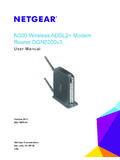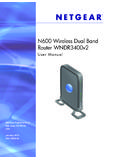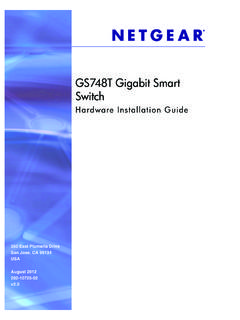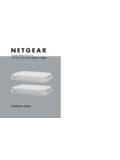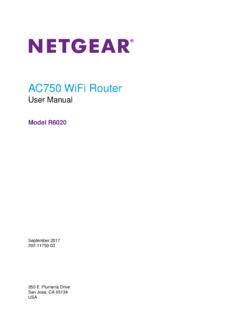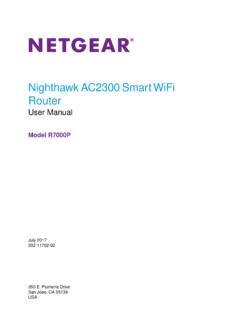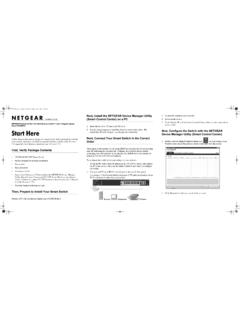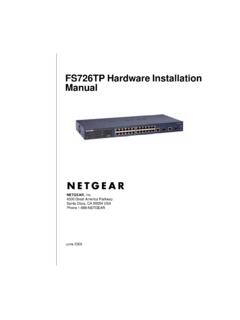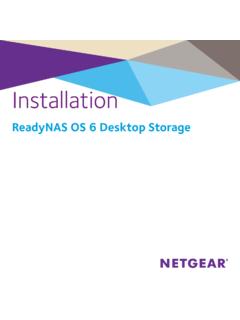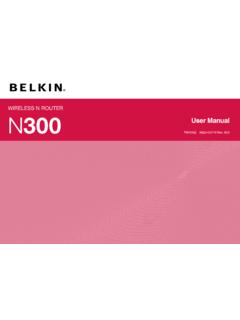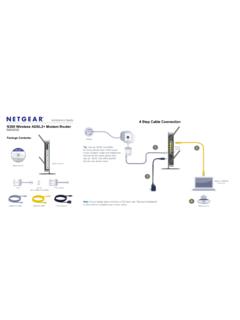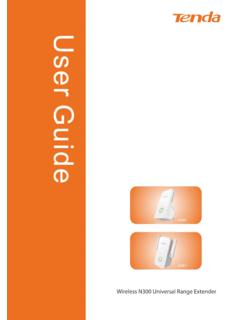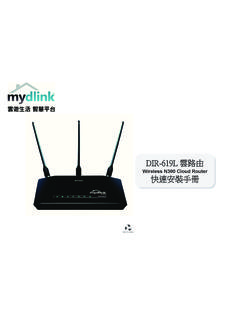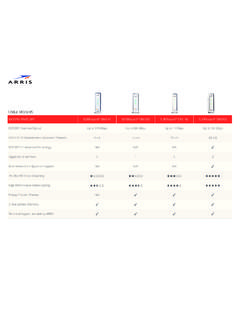Transcription of N300 Wireless Gigabit Router Setup Manual - Netgear
1 n300 Wireless Gigabit Router Setup Manual Netgear , Inc. 350 E. Plumeria Drive San Jose, CA 95134 USA. June 2010. 208-10443-03. 2010 by Netgear , Inc. All rights reserved. Trademarks Netgear and the Netgear logo are trademarks of Netgear . Inc. Microsoft, Windows, and Windows NT are registered trademarks of Microsoft Corporation. Wi-Fi Protected Setup is a trademark of the Wi-Fi Alliance. Other brand and product names are registered trademarks or trademarks of their respective holders. Statement of Conditions In the interest of improving internal design, operational function, and/or reliability, Netgear reserves the right to make changes to the products described in this document without notice. Netgear does not assume any liability that may occur due to the use or application of the product(s) or circuit layout(s) described herein.
2 Ii Contents n300 Wireless Gigabit Router Setup Manual Getting to Know Your Wireless 1. Unpacking Your New Router .. 1. Hardware Features .. 3. Front Panel .. 3. Back Panel .. 5. Router Label .. 5. Positioning Your Wireless Router .. 6. Installing Your n300 Wireless Gigabit Router .. 6. Updating Your Router Firmware .. 7. Installing Your Router Using the Smart Wizard .. 9. Using the Smart Wizard .. 9. Accessing Your Router After Installation .. 11. Manually Installing Your Router .. 12. Connecting Your n300 Wireless Gigabit Router .. 13. Verifying Your Connection .. 17. Setting Up Your Router for Internet Access .. 18. Configuring Your Wireless 22. Specifying Wireless Settings .. 22. Setting Your SSID and Wireless Security Manually .. 23. Using Push 'N' Connect (WPS) to Configure Your Wireless Network.
3 24. Testing Basic Wireless Connectivity .. 29. 30. Basic Setup Checklist .. 30. Checking Basic Router Functions .. 31. Troubleshooting Login Problems .. 33. Checking the Internet Service Connection .. 34. iii Obtaining an Internet IP Address .. 34. Troubleshooting PPPoE .. 35. Troubleshooting Internet Browsing .. 36. Using the Ping Utility to Troubleshoot .. 36. Testing the Path from Your Computer to Your Router .. 36. Testing the Path from a Computer to the Internet .. 37. Technical Specifications .. 39. Default Configuration Settings .. 39. Restoring the Default Password and Configuration Settings .. 40. Technical Specifications .. 41. Related Documents .. 43. Registration and 44. iv Getting to Know Your Wireless Router Congratulations on your purchase of a Netgear high-speed Wireless Router , the n300 .
4 Wireless Gigabit Router Model WNR3500L. The WNR3500L is also the Netgear Open Source Wireless -N Router . If you are interested in custom firmware and other third party applications, be sure to visit the Open Source community web site Before you begin installing your Router , check the package contents (see Unpacking Your New Router on page 1). Become familiar with the front and back panels of your Router especially the status lights and the important information on the Router label (see Hardware Features on page 3). Then, read the section on Positioning Your Wireless Router on page 6 to ensure that you have selected the best location to install your Router . Unpacking Your New Router Your product package should contain the following items: The Wireless Router A snap-on stand for your n300 Wireless Router An AC power adapter (varies by region).
5 A yellow Ethernet cable Netgear Installation Guide The Resource CD, which includes: The Smart Wizard ( ). A PDF version of this Manual A link to the online User Manual After your Router is installed and you have Internet access, you can access the online User Manual by clicking Documentation on the main menu. Getting to Know Your Wireless Router 1. If any of the parts are incorrect, missing, or damaged, contact your Netgear dealer. Keep the carton, including the original packing materials, in case you need to return the product for repair. To prepare your Router for installation: 1. Carefully peel off the protective film covering both sides of your Router (see Figure 1). Figure 1. 2. Set up your n300 Wireless Router by inserting the tabs of the stand (supplied with your Router ).
6 Into the slots on the bottom of your Router as shown in Figure 2. Then, remove the protective film covering the status light panel of the Router . Figure 2. Getting to Know Your Wireless Router 2. 3. Place your Router in a suitable area for installation (near an AC power outlet and accessible to the Ethernet cables for your wired computers). To ensure proper heat dissipation and for Router stability, it is important that you connect the stand and place your Router in an upright position. Hardware Features Before you install and connect your Router , take a moment to become familiar with important information on the label, and with the front and back panels of the Router especially the status lights on the front panel. Front Panel The Router front panel, shown in Figure 3, contains status lights.
7 (For more information on interpreting the status lights, see Verifying Your Connection on page 17 and Checking Basic Router Functions on page 31.). Getting to Know Your Wireless Router 3. Power On Amber The Router is performing the power-on self-test diagnostic. On Green The power is on and the Router is ready. Blink Amber A software update is in progress. Blink Green The firmware is corrupt. See Checking Basic Router Functions on page 31 for instructions on restoring your firmware. Off Power is not being supplied to the Router . Internet On Amber No IP address acquired. On Green The n300 Wireless Router has acquired an Internet address. Blink Green Data is being communicated with the Internet. Off No Ethernet cable is connected to the modem. Wireless On Blue The Wireless interface is enabled.
8 Blink Blue Data is being communicated over the Wireless network. Off The Wireless interface is turned off. LAN (Ports 1 4). On Green The local port is connected to a 1000 Mbps device. Blink Green Data is being transmitted at 1000 Mbps. On Amber The local port is connected to a 10/100 Mbps device. Blink Amber Data is being transmitted at 10/100 Mbps. Off No link is detected on this port. WPS button/light Blink Green Indicates WPS activity; the device is in the 2 minute interval to synchronize security or there is a WPS error. On Green Security set to WEP, WPA-PSK, or WPA2-PSK. Figure 3. Getting to Know Your Wireless Router 4. Back Panel The Router back panel contains port connections described in Figure 4. 1. Restore factory settings button. Press for approximately 5.
9 Seconds to reset the Router to the factory default settings. 2. USB port 3. Four Local Area Network (LAN) 10/100/1000 Mbps Ethernet ports for connecting the Router to your local computers. 4. Internet/Wide Area Network (WAN) Ethernet port for connecting the Router to a cable or DSL modem. 5. Power on/off push-button. 6. AC power adapter outlet for connecting the power adapter. Figure 4. Router Label The label on the back of the n300 Wireless Router shows the Router 's MAC address, serial number, security PIN, power on/off button, and factory default access login information. The ports on the Router are color-coded to distinguish your Internet port from the other four ports that connect to the wired computer(s) on your Local Area Network (LAN). Figure 5.
10 Getting to Know Your Wireless Router 5. Positioning Your Wireless Router The n300 Wireless Router lets you access your network from virtually anywhere within the operating range of your Wireless network. However, the operating distance or range of your Wireless connection can vary significantly depending on the physical placement of your Router . For example, the thickness and number of walls the Wireless signal must pass through might limit the range. For best results, place your Router : Near the center of the area where your computers and other devices will operate, preferably within line of sight to your Wireless devices. Accessible to an AC power outlet and near Ethernet cables for wired computers. In an elevated location such as a high shelf, keeping the number of walls and ceilings between the n300 Wireless Router and your other devices to a minimum.
